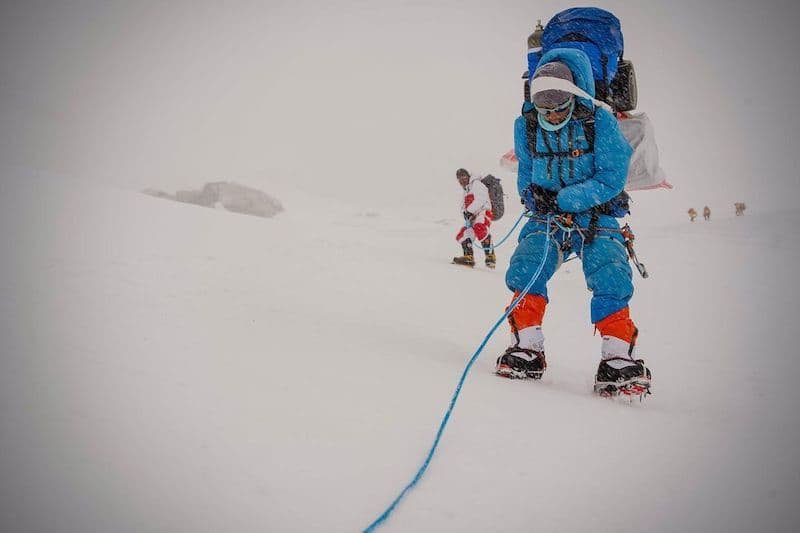
 Olivia Møller
Freediver - Activist - Explorer
Olivia Møller
Freediver - Activist - Explorer

 Olivia Møller
Freediver - Activist - Explorer
Olivia Møller
Freediver - Activist - Explorer
In the rarefied air of the Himalayas, where oxygen levels are sparse, Sherpas showcase a remarkable ability to extract and utilize oxygen with unparalleled efficiency. This prowess in oxygen utilization is not merely a consequence of genetic adaptations but involves a sophisticated interplay of physiological mechanisms that set the stage for Sherpas' hypoxia tolerance.
In Part 1 of our exploration into the hypoxia tolerance of Sherpas, we unraveled the genetic foundations that underpin their extraordinary resilience at high altitudes. We delved into the intricate adaptations related to oxygen transport, sensing, and utilization, painting a vivid picture of the genetic blueprint that distinguishes Sherpas in the realm of high-altitude adaptation.
Beyond the realm of genetics and physiology, the story of Sherpas' hypoxia tolerance is intricately woven into the fabric of their cultural practices and lifestyle. The daily routines, traditions, and adaptations forged over generations have played a pivotal role in shaping the resilience of the Sherpa community to the challenging conditions of high-altitude living.
Sherpas, from the earliest days of their lives, are exposed to the rigors of high-altitude living. Nestled in the heart of the Himalayas, their villages perch at elevations where oxygen levels are markedly lower than those at sea level. Children grow up navigating mountainous terrain, acclimatizing their bodies to the reduced oxygen available in the thin air. This lifelong exposure lays the foundation for a unique form of natural altitude training, fostering physiological adaptations that enhance oxygen utilization and mitigate the effects of hypoxia.
Sherpas engage in a range of physically demanding activities intrinsic to their mountainous environment. From daily tasks such as farming and herding livestock to more specialized pursuits like guiding trekkers and climbers, Sherpas partake in a lifestyle that demands physical exertion at high altitudes. This constant exposure to hypoxic conditions serves as a continuous training ground, honing their cardiovascular and respiratory systems to efficiently cope with reduced oxygen levels.

Photo by Pemba Sharwa
The Sherpa diet, shaped by the limitations of high-altitude agriculture, reflects a nutritional strategy tailored to the challenges of their environment. Rich in carbohydrates, which serve as a readily available energy source, and supplemented with proteins and fats, the traditional Sherpa diet provides the necessary nutrients for sustained physical activity at altitude. Additionally, their consumption of foods rich in antioxidants may play a role in mitigating oxidative stress, a common challenge in hypoxic conditions.
Sherpa culture is deeply intertwined with the formidable landscape they call home. Religious ceremonies and traditional practices often involve journeys to higher elevations, further reinforcing their acclimatization to hypoxic conditions. Sherpa rituals, such as the annual Mani Rimdu festival held at high-altitude monasteries, become not only cultural celebrations but also opportunities for communal gatherings that inherently support their adaptive lifestyle.
The Sherpa community, tightly-knit and interconnected, provides a unique support system. Shared experiences and accumulated knowledge about living at high altitudes are passed down through generations. This collective wisdom encompasses not only practical tips for altitude adaptation but also cultural resilience, fostering a sense of identity and purpose that contributes to the overall well-being of the community.

Photo by Pemba Sharwa
In the unforgiving realm of the towering Himalayan peaks, Sherpas' resilience to hypoxia reaches its zenith through the crucible of altitude-related activities. Mountaineering, trekking, and guiding expeditions in the rarefied air of high altitudes are not just pursuits of adventure for the Sherpas; they are transformative experiences that further sculpt their physiological responses and showcase the pinnacle of their adaptive capabilities.
Sherpas play a pivotal role in guiding mountaineering expeditions to some of the world's highest peaks. The challenges they face in these ventures go beyond the physical demands of scaling steep inclines. Sherpas navigate treacherous terrain, bearing the brunt of reduced oxygen levels that would be debilitating for many others. Guiding climbers through the thin air of the Himalayas is not only a profession for Sherpas but also a testament to their innate ability to thrive in altitudes where others struggle. Altitude-related activities expose Sherpas to a continuous and varied range of oxygen levels. Whether ascending steep slopes or descending into lower valleys, they encounter fluctuations in oxygen availability that serve as a dynamic form of altitude training. This constant exposure reinforces their physiological adaptations, ensuring that their bodies are finely tuned to efficiently utilize oxygen in a variety of high-altitude environments.

Photo by Mingma G
Altitude-related activities also demand heightened cognitive function, as Sherpas must navigate complex terrain and make critical decisions in challenging conditions. Studies have indicated that Sherpas exhibit cognitive adaptations, including enhanced memory and attention when exposed to high-altitude environments. This mental resilience is a crucial component of their ability to perform effectively in the oxygen-deprived landscapes they navigate.
The cardiovascular system of Sherpas undergoes unique adaptations through altitude-related activities. The demands of uphill treks and mountaineering expeditions challenge their hearts to pump blood more efficiently, optimizing the delivery of oxygen to vital organs. This cardiovascular conditioning, honed through years of high-altitude activities, contributes to Sherpas' ability to maintain physical performance at elevations that might induce fatigue and exhaustion in others.
Altitude-related activities are often communal endeavors for Sherpas. The camaraderie forged during expeditions not only enhances their collective resilience but also reinforces a shared identity. Team dynamics become an integral part of the altitude experience, fostering a support system that goes beyond individual physiological adaptations. The communal spirit becomes a source of strength, with each member contributing to the overall success of the expedition.

Photo by Mingma G
Within the Sherpa community, a rich tapestry of individual variations in genetic makeup unfolds, adding intricate layers to the narrative of hypoxia tolerance. While the collective genetic adaptations provide a foundation for Sherpas' resilience at high altitudes, the story becomes even more nuanced when one delves into the diverse genetic landscape that exists among individuals within this remarkable population.
Sherpas, like any human population, exhibit genetic diversity. This diversity is not only influenced by the ancestral history of the Sherpa people but also by the intermingling of genes over generations. The intricate mosaic of genetic variations includes not only those directly related to hypoxia tolerance but also an array of traits that contribute to the unique identity of each individual within the community.
While there are common genetic adaptations associated with Sherpas' hypoxia tolerance, there exists heterogeneity in the specific variants of these genes among individuals. Some Sherpas may possess variations that enhance certain aspects of oxygen transport, while others may exhibit unique combinations of genetic markers that contribute to their adaptive responses. The diverse genetic landscape within the Sherpa community gives rise to a spectrum of hypoxia tolerance, where individuals may differ in the degree to which they manifest these adaptations.

Photo by Mingma G
Research into Sherpas' genetic polymorphisms, or variations in specific genes, provides insights into the individual nuances of hypoxia tolerance. Polymorphisms in genes associated with oxygen sensing, hemoglobin regulation, and vascular responsiveness contribute to the spectrum of adaptations seen within the Sherpa population. The exploration of these polymorphisms unravels the intricate dance of genetic diversity, shaping the unique responses of individuals to the challenges of high-altitude living.
The individual variations within Sherpas extend beyond genes directly associated with hypoxia. The broader genetic landscape encompasses traits related to metabolism, immune function, and other physiological processes. This holistic genetic portrait contributes to the diversity of individual responses to high-altitude environments, reflecting the intricate interplay of nature and nurture.

Photo by Mingma G
The unique hypoxia tolerance exhibited by the Sherpa community extends beyond the realm of mountainous landscapes, offering profound implications for medical science. As researchers unravel the intricacies of Sherpas' adaptive mechanisms, a treasure trove of insights emerges, holding promise for advancements in understanding and treating various medical conditions related to oxygen transport and utilization.
Sherpas' exceptional ability to thrive in low-oxygen environments provides a valuable model for investigating respiratory and cardiovascular disorders. Studying the genetic adaptations and physiological responses that underlie Sherpas' hypoxia tolerance may unveil novel pathways and therapeutic targets for conditions such as chronic obstructive pulmonary disease (COPD) and various cardiovascular diseases. Insights gained from Sherpas' resilience could pave the way for innovative treatment strategies to enhance oxygen transport and mitigate the impact of hypoxia on affected individuals.
The exploration of individual variations within the Sherpa community opens avenues for the development of precision medicine approaches. Understanding how specific genetic profiles contribute to hypoxia tolerance allows for the tailoring of medical interventions based on an individual's unique genetic makeup. This personalized approach holds promise for optimizing treatments for respiratory, cardiovascular, and other conditions, taking into account the diverse genetic landscape that influences individual responses to therapeutic interventions.

Photo by Gesman Tamang
Sherpas' lifelong exposure to high altitudes positions them as a population uniquely adapted to mitigating altitude-related disorders. Insights gained from studying Sherpas' genetic and physiological adaptations may inform strategies for preventing and managing altitude sickness in non-adapted individuals, such as tourists, trekkers, and mountaineers. Understanding how Sherpas naturally acclimatize to low-oxygen environments may lead to the development of interventions to facilitate acclimatization in individuals not accustomed to high altitudes.
Sherpas' mastery over oxygen utilization holds implications for technological innovations in oxygen transport. Examining the efficiency of Sherpas' respiratory and circulatory systems may inspire the development of advanced respiratory devices, particularly for individuals with compromised lung function. Insights into how Sherpas optimize oxygen utilization could influence the design of medical devices and therapies aimed at improving oxygen delivery to tissues in various clinical scenarios.
Sherpas' unique adaptations offer an educational opportunity to raise awareness about the potential benefits of lifestyle and genetic diversity in promoting health. Lessons learned from Sherpas' resilience may inspire public health initiatives emphasizing the importance of physical activity, environmental exposure, and a holistic approach to well-being. Integrating these lessons into healthcare practices could contribute to preventive strategies for a range of health conditions.
As medical science delves into the study of Sherpas' hypoxia tolerance, it is crucial to approach research with cultural sensitivity and ethical considerations. Respecting the autonomy and privacy of the Sherpa community is paramount, and collaborative efforts with the community can ensure that research endeavors benefit both the scientific community and the Sherpas themselves.

Photo by Gesman Tamang
As scientists continue to explore the enigma of Sherpas' hypoxia tolerance, they face a tapestry of challenges and unanswered questions that beckon further investigation. The complexities inherent in deciphering the mechanisms behind Sherpas' remarkable adaptation call for a comprehensive approach, acknowledging the intricacies of genetic, physiological, and environmental factors. Here, we delve into the challenges faced and chart the course for future research directions in this captivating field.
One of the foremost challenges lies in disentangling the intricate web of genetic adaptations within the Sherpa population. While certain genes associated with oxygen transport and utilization have been identified, the interplay of these genes and the presence of additional contributors to hypoxia tolerance remain elusive. Future research must delve deeper into the genomics of Sherpas, exploring rare variants, gene-gene interactions, and epigenetic factors that contribute to the nuanced spectrum of hypoxia resilience observed among individuals.
Understanding the individual variations within the Sherpa community poses a unique challenge. The extent to which genetic diversity influences hypoxia tolerance on an individual level remains an open question. Future studies should aim to unravel the specific genetic signatures that contribute to variations in adaptive responses among Sherpas, recognizing that a one-size-fits-all approach may not capture the full richness of their genetic diversity.
To comprehensively grasp the mechanisms of Sherpas' hypoxia tolerance, a multi-omics approach is essential. Integrating genomics, transcriptomics, proteomics, and metabolomics can provide a holistic understanding of how genetic information translates into functional adaptations. The challenge lies in harmonizing these diverse datasets to unveil the intricate molecular orchestration that underlies Sherpas' resilience to low-oxygen environments.

Photo by Gesman Tamang
While genetic adaptations are pivotal, environmental factors play a significant role in shaping Sherpas' hypoxia tolerance. Future research should explore how lifestyle, altitude-related activities, and cultural practices interact with genetic predispositions. Understanding the dynamic interplay between genetics and environment is essential for deciphering the complete story of Sherpas' adaptation to high-altitude living.
Sherpas' hypoxia tolerance is a result of lifelong exposure to high altitudes. Conducting longitudinal studies that follow individuals from birth to adulthood can provide insights into the temporal aspects of adaptation. Tracking changes in genetic expression, physiological responses, and cognitive function over time can unravel the developmental trajectory of hypoxia tolerance within the Sherpa population.
Translating the knowledge gained from Sherpas' hypoxia tolerance into medical applications is a challenging yet promising frontier. Future research should explore how the insights gleaned from Sherpas can inform the development of therapies for respiratory and cardiovascular disorders, altitude sickness prevention, and other conditions related to oxygen utilization. Bridging the gap between basic research and clinical applications holds the potential to revolutionize medical approaches in oxygen-deprived environments.
As researchers embark on the journey to unravel Sherpas' hypoxia tolerance, maintaining cultural sensitivity and ethical considerations is paramount. Collaborative efforts with the Sherpa community, respecting their traditions, and ensuring that research benefits the community are essential principles guiding future studies. Establishing ethical frameworks that prioritize the well-being and autonomy of the Sherpa population is crucial for the integrity and sustainability of research endeavors.

Photo by Pemba Sharwa
In the rarefied air of the Himalayas, Sherpas stand as living testaments to the marvels of human adaptation. Their hypoxia tolerance, shaped by a symphony of genetic, physiological, and cultural factors, continues to captivate scientists and enthusiasts alike. As we delve deeper into the secrets of Sherpas' resilience, we unlock not only the mysteries of high-altitude survival but also potential avenues for advancing medical science and understanding the remarkable adaptability inherent in the human body.